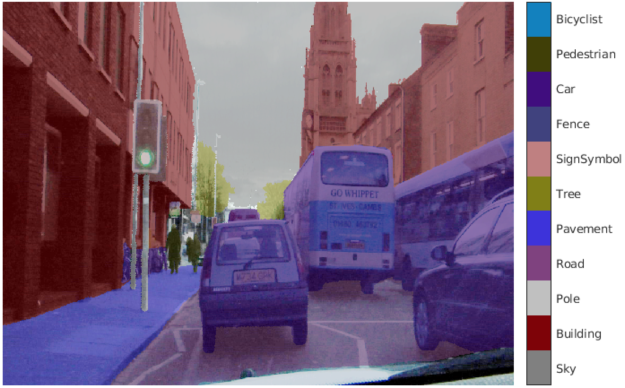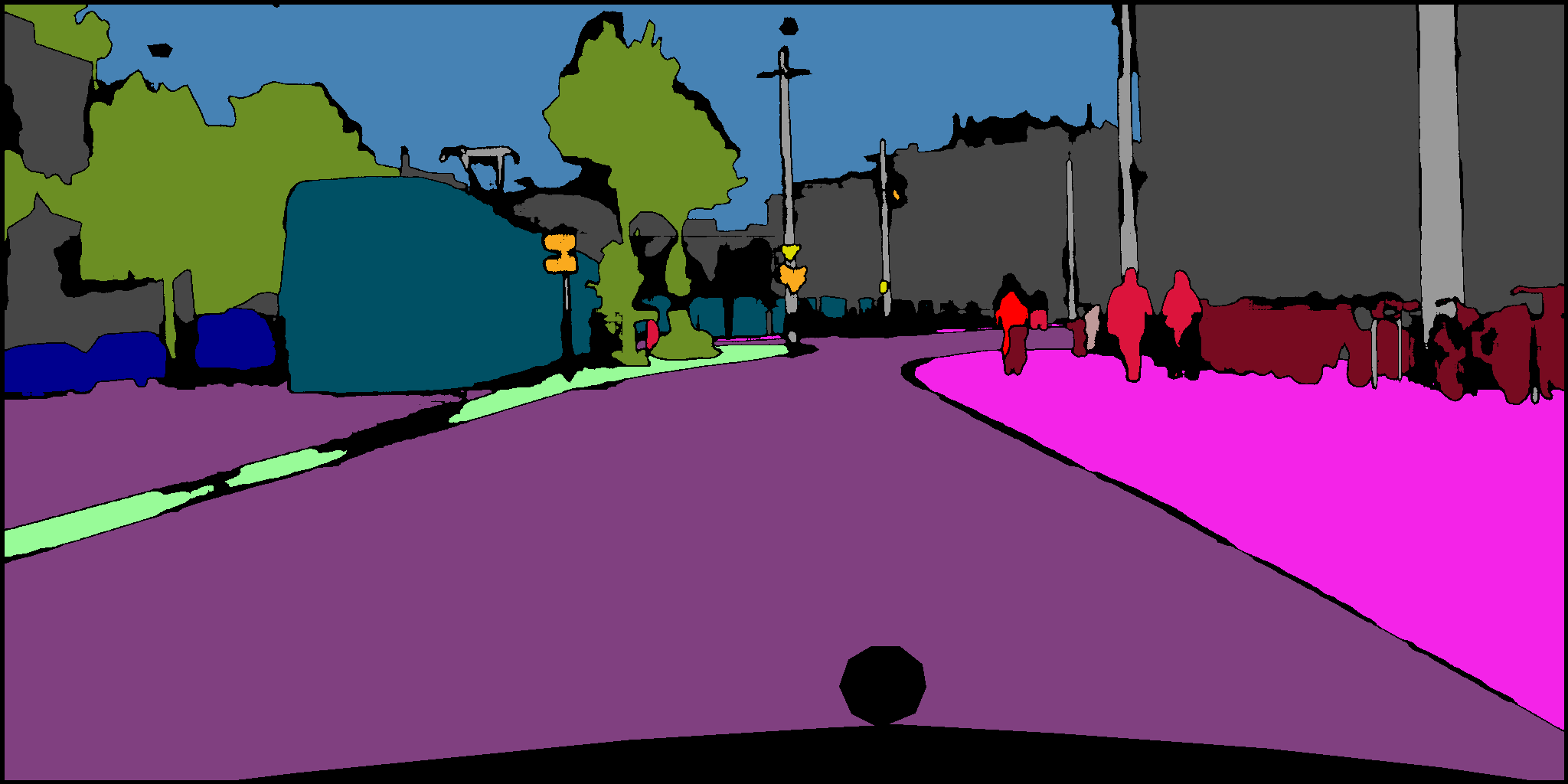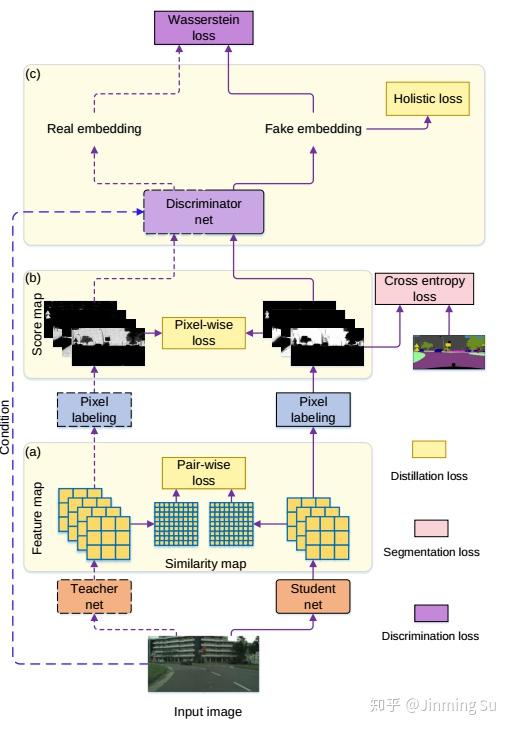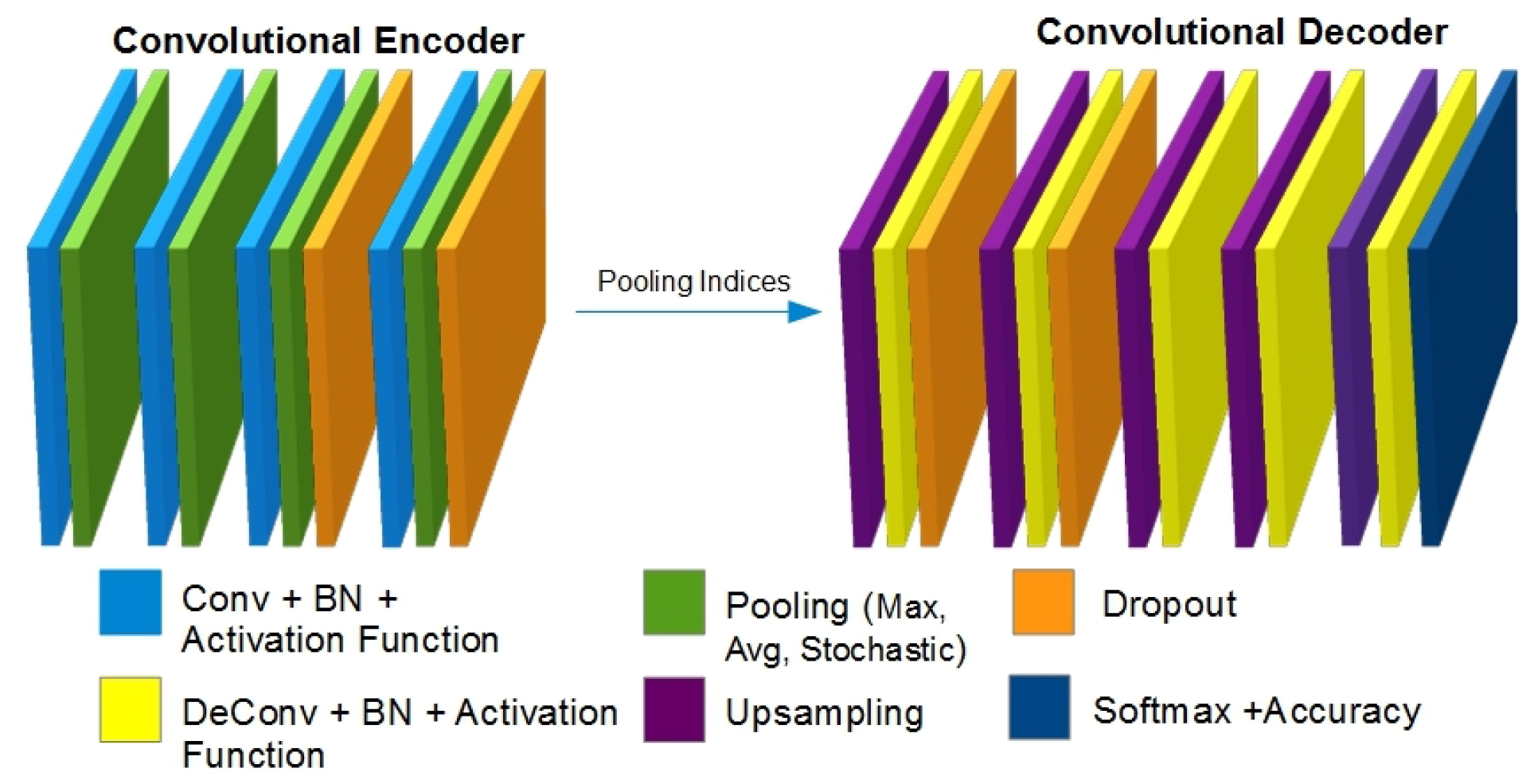43 in semantic segmentation pixel labels
Semantic segmentation inference of pixels with ignore_index vision. ALMOUDI (MOHAMAD MOSTAFA) May 13, 2022, 4:48pm #1. Hello, I am applying segmentation on a dataset with 4 semantic labels and 1 null label 255 which is included in ignore index in loss function. When I test my model and visualize the prediction models seems to be giving values of one of the 4 semantic labels to the ignore index pixels. Don't Miss A Pixel with Semantic Segmentation Pixel Enforcement When it comes to semantic segmentation you strive for pixel-perfect accuracy, and this can become quite a complicated task. For example, with occluded objects. If you want a fine-tuned...
In-depth Guide to Semantic Segmentation - AIMultiple Semantic segmentation architecture mainly consists of an encoder and decoder network. Encoder takes image data as an input. It prepares image data for the usage of the decoder. It processes image data to extract statistical properties of the image such as the number of pixels. These features help to label and locate objects in a further step.
In semantic segmentation pixel labels
What is Semantic Segmentation - Beginners Guide Semantic segmentation is a method for distinguishing between different things in an image. At the pixel level, it might be regarded an image categorization problem. For the job of semantic segmentation, the deep learning methods we outlined have sped up the creation of algorithms that can be employed in real-world scenarios with promising outcomes. arxiv.org › pdf › 2203Semi-Supervised Semantic Segmentation Using Unreliable Pseudo ... The crux of semi-supervised semantic segmentation is to assign adequate pseudo-labels to the pixels of unlabeled images. A common practice is to select the highly confident predictions as the pseudo ground-truth, but it leads to a problem that most pixels may be left unused due to their unreliability. We argue that every pixel matters to the model Semi-Supervised Semantic Segmentation Using Unreliable Pseudo-Labels The crux of semi-supervised semantic segmentation is to assign adequate pseudo-labels to the pixels of unlabeled images. A common practice is to select the highly confident predictions as the pseudo ground-truth, but it leads to a problem that most pixels may be left unused due to their unreliability.
In semantic segmentation pixel labels. Incremental Learning in Semantic Segmentation from Image Labels Furthermore, pixel-by-pixel annotations are expensive and time-consuming. This paper proposes a novel framework for Weakly Incremental Learning for Semantic Segmentation, that aims at learning to segment new classes from cheap and largely available image-level labels. CCNet: Criss-Cross Attention for Semantic Segmentation mantic class labels to each pixel in the given image. It has been extensively and actively studied in many recent works and is also critical for various challenging and meaningful applications such as autonomous driving [14], augmented reality [1], and image editing [13]. Specifically, current state-of-the-art semanticsegmentation approaches based on ∗The work was mainly done … Semantic Segmentation of Aerial Imagery captured by a Drone ... - Medium Figure 1. Object Detection, Semantic Segmentation, Instance Segmentation, source As seen in the picture above, detecting the objects in the content of the image with the bounding box is called object detection.Semantic segmentation which is a pixel-wise labeling operation is to display the same type of objects (sky, cat, dog, human, road, car, mountain, sea, etc) in the picture with a label ... en.wikipedia.org › wiki › Image_segmentationImage segmentation - Wikipedia Instance segmentation is an approach that identifies, for every pixel, a belonging instance of the object. It detects each distinct object of interest in the image. For example, when each person in a figure is segmented as an individual object. Panoptic segmentation combines semantic and instance segmentation. Like semantic segmentation ...
cnvrg.io › semantic-segmentationSemantic Segmentation - The Definitive Guide for 2021 - cnvrg The process of linking each pixel in an image to a class label is referred to as semantic segmentation. The label could be, for example, cat, flower, lion etc. Semantic segmentation can be thought of as image classification at pixel level. Therefore, in semantic segmentation, every pixel of the image has to be associated with a certain class label. Semantic Segmentation; A brief overview - KlearStack AI Semantic segmentation is the process where we classify each pixel of an image that belongs to a particular label/ class. There is no difference between separate instances of the same object. For example, if the image contains two apples, semantic segmentation will give all pixels of both apples the same name. Instance Segmentation 1 DeepLab: Semantic Image Segmentation with Deep Convolutional … employ segmentation algorithms that are decoupled from the DCNN classifier’s results, thus risking commitment to premature decisions. The third family of works uses DCNNs to directly provide dense category-level pixel labels, which makes it … › semantic-segmentationSemantic Segmentation - MATLAB & Simulink - MathWorks Semantic segmentation is a deep learning algorithm that associates a label or category with every pixel in an image. It is used to recognize a collection of pixels that form distinct categories. For example, an autonomous vehicle needs to identify vehicles, pedestrians, traffic signs, pavement, and other road features.
towardsdatascience.com › understanding-semanticUnderstanding Semantic Segmentation with UNET - Medium Feb 17, 2019 · The goal of semantic image segmentation is to label each pixel of an image with a corresponding class of what is being represented. Because we’re predicting for every pixel in the image, this task is commonly referred to as dense prediction. Note that unlike the previous tasks, the expected output in semantic segmentation are not just labels ... (SP)Net for Generalized Zero-Label Semantic Segmentation In generalized zero-label semantic segmentation (GZLSS) [ 5, 11, 19, 31 ], the goal is to make pixel-level predictions for both seen classes with abundant labels and novel classes without any label. Prior methods mainly focus on learning feature generators [ 5, 11, 19] or a semantic projection layer [ 31 ]. Semantic Segmentation - The Definitive Guide for 2021 - cnvrg The process of linking each pixel in an image to a class label is referred to as semantic segmentation. The label could be, for example, cat, flower, lion etc. Semantic segmentation can be thought of as image classification at pixel level. Therefore, in semantic segmentation, every pixel of the image has to be associated with a certain class label. An Ultimate Guide to Understanding Semantic Segmentation In simple words, semantic segmentation can be defined as the process of linking each pixel in a particular image to a class label. These labels could include people, cars, flowers, trees, buildings, roads, animals, and so on. The list is endless. Thus, it is image classification at the pixel level.
Semantic Segmentation with SegFormer | by Praneet Bomma - Medium We have the labels CSV which can be used for plotting the colors on the segmented image. classes = pd.read_csv ('class_dict_seg.csv') ['name'] id2label = classes.to_dict () label2id = {v: k for k,...
Fine-Tune a Semantic Segmentation Model with a Custom Dataset To create your semantic segmentation dataset, you'll need two things: images covering the situations your model will encounter in the real world; segmentation labels, i.e. images where each pixel represents a class/category. We went ahead and captured a thousand images of sidewalks in Belgium.
Semantic segmentation tutorial Part 1 Image Segmentaion Semantic segmentation is the task of partitioning an image to coherent parts, and assigning a class label at each part. That is, per pixel classification of an image. This is an example of an image with it's corresponding segmentation mask (i.e. the pixel labels). In this, green stands for trees, blue for buildings, yellow for cars and so on.
Yangzhangcst/RGBD-semantic-segmentation - GitHub 18/05/2022 · RGBD semantic segmentation. A paper list of RGBD semantic segmentation. *Last updated: 2022/05/18. Update log. 2020/May - update all of recent papers and make some diagram about history of RGBD semantic segmentation. 2020/July - update some recent papers (CVPR2020) of RGBD semantic segmentation. 2020/August - update some recent papers …

Speeding Up Semantic Segmentation Using MATLAB Container from NVIDIA NGC | NVIDIA Developer Blog
Semantic Segmentation Using Pixel-Wise Adaptive Label ... - ResearchGate Here, we propose a new regularization method called pixel-wise adaptive label smoothing (PALS) via self-knowledge distillation to stably train semantic segmentation networks in a practical...

4D lidar semantic segmentation: a leap forward in 3D annotation | Autonomous Vehicle International
learnopencv.com › applications-of-foregroundApplications of Foreground-Background separation with ... Jul 23, 2019 · Recall that semantic segmentation is a pixel-wise classification of the labels found in an image. The above figure shows an example of semantic segmentation. Each label is mapped to its corresponding color. The class “person” for example has a pink color, and the class “dog” has a purple color.

Block Annotation: Better Image Annotation for Semantic Segmentation with Sub-Image Decomposition ...
What Is Instance Segmentation - Apps And How Does It Works? Segmentation is an important step in picture analysis. Semantic segmentation assigns the most likely class label to each pixel of an image from a finite set of possible labels. It's not a new concept in aerial photography. It's worth noting that semantic segmentation of satellite and aerial photos has gotten a lot of attention in recent years.
SePiCo: Semantic-Guided Pixel Contrast for Domain ... - Papers With Code Considering the possible lack of category diversity in semantic concepts, we then blaze a trail of distributional perspective to involve a sufficient quantity of instances, namely distribution-aware pixel contrast, in which we approximate the true distribution of each semantic category from the statistics of labeled source data.
Semantic Segmentation Using Pixel-Wise Adaptive Label Smoothing via ... Semantic Segmentation Using Pixel-Wise Adaptive Label Smoothing via Self-Knowledge Distillation for Limited Labeling Data by Sangyong Park 1, Jaeseon Kim 1 and Yong Seok Heo 1,2,* 1 Department of Electrical and Computer Engineering, Ajou University, Suwon 16449, Korea 2 Department of Artificial Intelligence, Ajou University, Suwon 16449, Korea *
Class-Balanced Pixel-Level Self-Labeling for Domain Adaptive Semantic ... Domain adaptive semantic segmentation aims to learn a model with the supervision of source domain data, and produce satisfactory dense predictions on unlabeled target domain. One popular solution to this challenging task is self-training, which selects high-scoring predictions on target samples as pseudo labels for training.
GitHub - trived76/Semantic-Segmentation: Digital Image Processing Course project: Semantic ...
Weakly-Supervised Semantic Segmentation by Learning Label ... - DeepAI Our goal is to perform semantic segmentation, which can segment objects with their true borders instead of rectangular shapes as seen in Figure 2. Instead of only learning the uncertainty for "difficult" pixels, which is built-in in the loss function, we will force the loss to learn a kind of label uncertainty.
Scientists create algorithm to assign a label to every pixel in the ... Scientists create algorithm to assign a label to every pixel in the world, without human supervision by Rachel Gordon, Massachusetts Institute of Technology Unsupervised semantic segmentation predictions on the "CocoStuff 27" segmentation challenge. STEGO does not use labels to discover and segment consistent objects.
Learning From Pixel-Level Label Noise: A New Perspective for Semi ... This paper addresses semi-supervised semantic segmentation by exploiting a small set of images with pixel-level annotations (strong supervisions) and a large set of images with only image-level annotations (weak supervisions). Most existing approaches aim to generate accurate pixel-level labels from weak supervisions. However, we observe that those generated labels still inevitably contain ...
Understanding Semantic Segmentation with UNET - Medium 17/02/2019 · Semantic Segmentation. The goal of semantic image segmentation is to label each pixel of an image with a corresponding class of what is being represented. Because we’re predicting for every pixel in the image, this task is commonly referred to as dense prediction.. Note that unlike the previous tasks, the expected output in semantic segmentation are not …
[2203.08414] Unsupervised Semantic Segmentation by Distilling … 16/03/2022 · Unsupervised semantic segmentation aims to discover and localize semantically meaningful categories within image corpora without any form of annotation. To solve this task, algorithms must produce features for every pixel that are both semantically meaningful and compact enough to form distinct clusters. Unlike previous works which achieve this with a …
2D Semantic Labeling Focus is on detailed 2D semantic segmentation that assigns labels to multiple object categories. Further research drivers are very high-resolution data from new sensors and advanced processing techniques that rely on increasingly mature machine learning techniques. Despite the enormous efforts spent, these tasks cannot be considered solved, yet.






![[CVPR2014]Dense Semantic Image Segmentation with Objects and Attributes - YouTube](https://i.ytimg.com/vi/SvKFZaXIG_A/maxresdefault.jpg)


Post a Comment for "43 in semantic segmentation pixel labels"